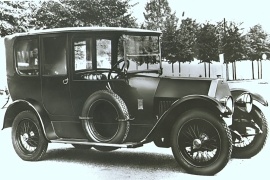Segment: Medium
Production years: 1913, 1914, 1915, 1916, 1917, 1918, 1919
 2 Photos
2 PhotosThe Italian automaker Lancia started to become known in Europe for its sporty cars, and after the 1908 18/24hp model came the Theta, also known as the 25/35 due to its engine’s power and fiscal category.
After creating a few inline-four-powered vehicles named after the Latin alphabet, the first major success recorded by the young Italian automaker was the 1913 Theta. It was a revolutionary car since it featured unseen features, such as an electric starter, an exhaust cut-out system, and a push-button horn, to name just a few. These amenities stirred the British market, where Lancia was the most successful. He developed the civilian vehicle after it developed some mechanical parts for the Italian army, so the result exceeded customers’ expectations.
Lancia made the Theta with a choice of a few bodyworks to be more appealing to a broader range of customers. Regardless of which buyers chose, all of them had the same front fascia with a brass radiator that sported an angular shape at the front and a small engine compartment where a four-banger engine was housed. A pair of big round headlamps were cramped between the radiator and the slim front fenders that covered the upper part of the wire wheels.
From its profile, the Theta showed its high ground clearance since the car was built on a ladder-frame chassis with curved endings. A straight-up windshield protected the driver and side passenger from road debris, dust, and elements. Depending on the version, the car could be ordered as a sedan, a two-door coupe, or a four-door convertible. But for those times, that was considered more than enough. The narrow doors were not fitted with windows, but they featured a locking mechanism. Lancia also offered the vehicle with torpedo-style bodywork that featured a canvas roof and four doors.
During those years, most cars were fitted with similar features, but Lancia dared to make a difference. The Italian automaker worked together with the American company Rushmore to develop a six-volt electrical system that featured a pedal button for the electric starter, a button for the horn, and electric lights. In addition, Lancia added another pedal for the exhaust cut-out system that was used to stop the engine. As a result, the car had five pedals instead of three, which made it somehow difficult to operate.
Lancia Theta was available with a short or a long-wheelbase, depending on customers' needs. Under the hood, Lancia installed an inline-four engine carried over from the Eta version of the Alpha model. It was paired with a four-speed manual gearbox that sent the power to the rear wheels. The side-valve engine initially produced 35 PS (34 hp), but it was later upgraded to provide 70 PS (68 hp).
LANCIA Theta 1913, 1914, 1915, 1916, 1917, 1918, 1919
- 4.9
LANCIA Theta
4.9
ENGINE SPECS - 4.9 | |
|---|---|
| Cylinders: | L4 |
| Displacement: | 4942 cm3 |
| Power: | 51 KW @ 2500 RPM 70 HP @ 2500 RPM 68 BHP @ 2500 RPM |
| Fuel System: | Carburetor |
| Fuel: | Gasoline |
TRANSMISSION SPECS | |
|---|---|
| Drive Type: | Rear Wheel Drive |
BRAKES SPECS | |
|---|---|
| Front: | Drums |
| Rear: | Drums |

